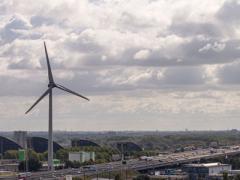Global roll-out of successful policies may help limit global warming to well below 2 °C
An accelerated, global roll-out of good practices in reducing greenhouse gas emissions may help to limit global warming to well below 2 °C, as agreed in the Paris Agreement on climate change. This is the main outcome of the newly developed Bridge scenario, which - if implemented effectively - will narrow the global emission gap between reductions announced in the Nationally Determined Contributions (NDCs) and those needed for a cost-optimal well below 2 °C scenario by two thirds, by 2030. After 2030, more comprehensive mitigation measures are needed, if we are to keep well below 2 °C within reach. Although a wide set of good practice policies is included in the scenario, these are insufficient - even if all would be jointly implemented - to put the world on track to limit global warming to 1.5 °C.
Good practice policies have proven themselves in one or several countries, resulting in significant greenhouse gas emission reductions. Examples are the current EU fuel efficiency standards for cars, and the Brazilian Forest Code that helped reduce deforestation around 2012, the importance of which is now reiterated in the Glasgow Leaders’ Declaration on Forests and Land Use at COP26.
The question is what would happen if the impact of such policies would be replicated worldwide. To this end, the Bridge scenario was developed by a consortium of researchers from various institutes, under the leadership of PBL Netherlands Environmental Assessment Agency. The scenario is being published today, in an article in Nature Communications. It is based on nationally relevant, short-term measures developed in consultation with country experts. Under the scenario, these good practice policies are rolled out, globally, between now and 2030 and will be combined with carbon pricing thereafter.
Bridge scenario developed because of remaining emission gap after implementation of NDCs
Parties to the Paris Agreement were supposed to submit updated NDCs and communicate their long-term strategies to the UNFCCC by 2020. Due to the COVID-19 pandemic, the timeline has been delayed. The aggregated impact of current NDCs will be insufficient. In addition, global emission levels under nationally implemented policies will, collectively, even exceed the levels projected under current NDCs. Therefore, scaling up climate ambition levels and efforts remains necessary to keep the Paris Agreement goals within reach. As the emission gap appears difficult to close, a set of relevant scenarios was developed that may provide a pathway towards doing so, based on examples of successful policies.
Accelerated roll-out of good practices politically more feasible and cheaper in the long run
The scenarios are intended to provide guidance for policy-making by focusing on concrete policy measures that could be implemented to close the emission gap. In order to discuss the possible impacts of the Bridge scenario, it was compared to four other scenarios. The comparison focused on the impact of:
- current policies;
- NDCs, including the more ambitious conditional targets that require external support for their implementation;
- immediate cost-optimal action towards achieving the well below 2 °C target; and
- delayed cost-optimal action towards achieving this target.
One of the main outcomes of the Bridge scenario is the short-term implementation of practical regulation-based policies being preferable over delayed climate action. Another also suggests that taking early action on good practice policies will be less costly, in the long term, than delaying global climate cooperation. A global roll-out and successful implementation of good practice policies could put the world on a pathway that is compatible with achieving the well below 2 °C target without posing large additional challenges. A focus on successfully implemented policies will likely have short-term advantages in terms of political feasibility, compared to an approach that focuses solely on the largest greenhouse gas reduction at the lowest costs.
Other examples of good practices
A good practice policy included in the Bridge scenario is the strong increase in electric and other low-carbon vehicle sales, as the experience in Norway has shown. Another example is that of halting the construction of new coal-fired power plants that have no carbon capture and storage, by 2025 for high-income countries and by 2030 for low- to medium-income countries. Following examples from Germany and Denmark, the Bridge scenario also includes measures for the agricultural sector, such as treatment of livestock manure with anaerobic digesters to reduce methane emissions. Although, under the scenario, the timing and stringency of measures differs per income group, measures will have to be adjusted to the national context.
With these and other measures across all sectors of the economy, the Bridge scenario leads to a scale-up of renewable energy (reaching 52% to 88% of global electricity supply by 2050), electrification of end-uses, efficiency improvements in energy demand sectors, and enhanced afforestation and reforestation.

